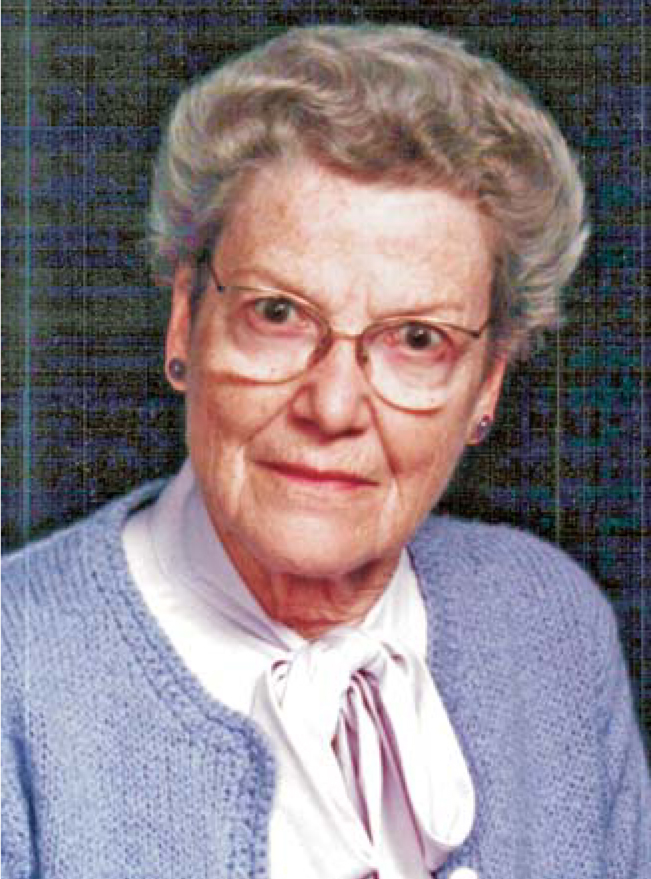Elizabeth Armstrong Wood
DOI: 10.1063/1.2435658
Elizabeth Armstrong Wood, first woman scientist at Bell Telephone Laboratories, died of a stroke on 23 March 2006 in Freehold, New Jersey.
Betty was born on 19 October 1912 in New York City and earned a BA degree in geology in 1933 from Barnard College. She then went to Bryn Mawr College, where she was awarded an MA in geology in 1934 and a PhD in geology in 1939. Her interest in crystallography was greatly encouraged at Bryn Mawr by Lindo Patterson, who was in the physics department. After working as an instructor in geology and mineralogy at Bryn Mawr and Barnard and as a research assistant at Columbia University, Betty joined the physics research department at Bell Telephone Laboratories in Murray Hill, New Jersey, in 1943; she maintained a research program there until she retired in October 1967.
Betty’s scientific studies were in x-ray crystallography and involved new semiconducting, lasing, magnetic, and superconducting materials, with an emphasis on those displaying both ferromagnetic and piezoelectric properties. She also investigated the effects of oriented electric fields on a variety of materials. In those early days of crystal-structure determination, she contributed expertly to the development of methods for measuring and interpreting x-ray diffraction patterns.
Whether through discussions at lunch or in the corridor or through direct collaboration, Betty’s interactions with other researchers at Bell Labs contributed immeasurably to the mutual advancement of their science. Her scientific advice was constantly sought, as acknowledged in the company’s official history A History of Engineering and Science in the Bell System: Physical Sciences (1925–1980) (AT&T Bell Laboratories, 1983). She collaborated with many outstanding scientists who were among the most inventive minds at Bell Labs, including Richard Bozorth, Bernd Matthias, Robert Miller, Walter Bond, Lester Germer, Alan Holden, and Joseph Remeika. The AT&T historical account notes that Betty’s work “helped to develop an understanding of the relationship between physical properties and crystal structure and made possible the synthesis of many new substances with predictable properties. Substituent atoms could be introduced into a known structure in a controlled way, and the relationship between properties and the substituents at known sites could be quantitatively determined.” The management of Bell Labs greatly appreciated Betty and often asked her to help with ceremonial duties. The Bell Labs Picturephone service, for example, was inaugurated in 1964 by a phone call from Mrs. Lyndon B. Johnson in the White House to Betty, accompanied by New York Mayor Robert F. Wagner Jr, at the Picturephone center in Grand Central Terminal.
Betty was strongly involved in the formation of the American Crystallographic Association. In 1947, when she was secretary of the American Society for X-Ray and Electron Diffraction, she collaborated with William Parrish, secretary of the Crystallographic Society of America, in inviting the newly formed International Union of Crystallography (IUCr) to hold its first congress at Harvard University. It was at that congress in 1948 that a merger of ASXRED and CSA was discussed by the officers of both societies, who presented a plan that was hotly debated and eventually accepted by both groups. As a result, Betty, together with Isidor Fankuchen, Parrish, and Patterson, drafted a constitution for the proposed American Crystallographic Association. In 1957 she became the ACA’s first woman president; the second, Isabella L. Karle, was not elected until 1976.
Betty served the crystallographic community in many other ways. She was a member of the Governing Board of the American Institute of Physics (1963–69), AIP’s Visiting Scientist Program (1961–72), the NSF-sponsored Commission on College Physics (1967–71), the NSF project Physical Science for Nonscience Students (1965–71), the School Mathematics Study Group (1966–69), and the IUCr Commission on Crystallographic Teaching (1969–72). She chaired the US delegation to the second IUCr General Assembly in 1951 and was a delegate to the eighth assembly in Stonybrook in 1969.
Betty was a wonderful and dedicated teacher. The many books she wrote, including Crystals and Light: An Introduction to Optical Crystallography (Van Nostrand, 1964), earned her a reputation for clearly written texts. Her book Science for the Airplane Passenger (Houghton Mifflin, 1968) also proved successful. Her deep interest in improving the scientific understanding of the general public was recognized by the ACA’s establishment of the Elizabeth A. Wood Science Writing Award, whose purpose is to honor the authors of outstanding publications that bring science to the public’s attention. The first award was presented in 1997 to Nobel laureate Roald Hoffmann.
Betty’s interests were not confined to science. For many years she and her husband, Sandy, hybridized and raised beautiful irises in their Murray Hill garden, and she was president of the Garden State Iris Society and the Median Iris Society. She loved ocean sailing and spent much time on her sailboat. But she always maintained a keen and active interest in crystallographic problems.

Elizabeth Armstrong Wood

More about the Authors
Sidney C. Abrahams. 1 Southern Oregon University, Ashland, US .
Jenny P. Glusker. 2 Fox Chase Cancer Center, Philadelphia, US .
